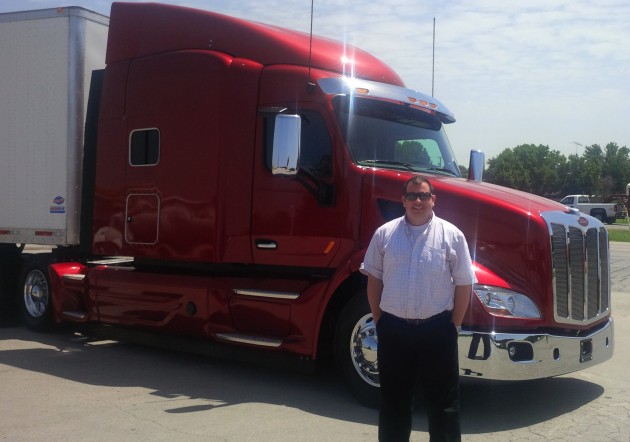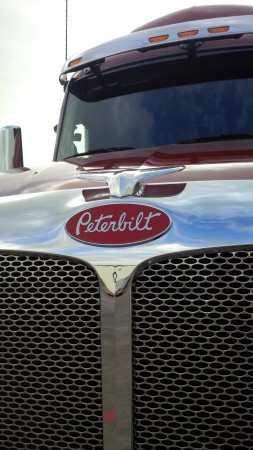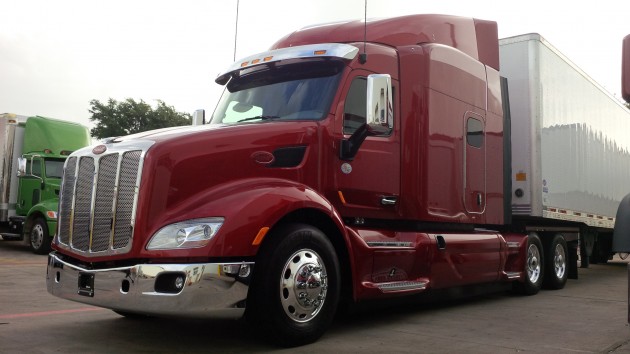Driving the Peterbilt Model 579 EPIQ
DENTON, Texas — In the 75 years that Peterbilt has been building trucks, fuel economy has never been more important than it is today. So this is a big year for the truck maker, not only because it’s celebrating a significant milestone with its 75th birthday, but with the introduction of the Model 579 EPIQ package, Peterbilt has brought to market its most fuel-efficient truck ever.
I recently had the chance to spend a couple hours driving the new Model 579 with EPIQ package, which consists of a set of specifications that collectively boost fuel economy as much as 10% compared to a 579 with a 2013 model year Paccar MX engine and Eaton UltraShift Plus automated manual transmission (AMT).
Improvements to Eaton’s Fuller Advantage AMT have reduced weight by about 80 lbs, and when optimized to perform with the Paccar MX-13 engine in what is being dubbed the APEX powertrain, the EPIQ package derives about a 4% fuel savings from the powertrain alone.

A complete aerodynamic package featuring full chassis fairings, including eight-inch rubber flares and rubber skirts, nets another 3% improvement. EPIQ also comes with the Bendix SmarTire tire pressure monitoring system, which typically improves fuel economy by 2% and then there’s the soon-to-be-released driver performance coaching system, which via the in-dash display advises drivers on how to improve their braking, coasting and acceleration to stretch their fuel mileage even further. This was supposed to provide another 1% in fuel economy improvements, bringing the total to 10%, but Anthony Gansle, marketing manager, on-highway product with Peterbilt, says early field testing has shown the coaching system has surpassed expectations. It will be released in Peterbilt trucks with the APEX powertrain next month and with other powertrains next March.
Of course, it takes more than a couple of hours over flat Texas Interstate to properly evaluate fuel economy, so I won’t even try; these claims will be tested by the market in the months ahead. I can, however, share some thoughts on the overall driving experience provided by the Model 579 after what was my first drive with the vehicle.
Introduced in 2012, the Model 579 features a new 2.1-metre stamped aluminum cab. During the development process, Peterbilt built an adjustable cab and then queried some 500 drivers on their preferences. Most indicated a 2.1-metre cab width provided the best combination of ergonomics, comfort, visibility and maneuverability. The cab is well designed so that it doesn’t feel at all cramped, yet it’s a little more forgiving when travelling down the highway than a 2.3-metre cab, which can be a bit of a handful in tight spaces. If you want the extra width, Peterbilt still offers it in the form of the 587.
With the new cab, Peterbilt moved from huckbolt to Hemrob construction; the latter providing self-piercing rivets that form a head and tail upon penetration, establishing a stronger connection. The cab is shared between the 579 and the 567 vocational truck, so it was designed to be lightweight yet durable enough to survive the abuse faced in vocational environments.
Interestingly, Peterbilt has chosen to mount the side mirrors directly onto the door rather than the A-pillar, and in doing so, made the A-pillar some 13% thinner. This provides greater visibility in front of the mirror and beyond the A-pillar. I expected the new mounting point to provide some additional vibration but on the highway, the mirrors were as steady as any others and the extra visibility was noticeable. And by mounting the mirrors to the doors, drivers can now open their door a smidge to get a more complete view along the side of the trailer when preparing to back up.

Visibility out of the 579 was also improved by extending the height of the windshield at both the top and bottom, which is useful when stopped underneath a set of traffic lights.
The doors on the 579 are car-like, closing with little force and even less noise. They’re also triple-sealed to reduce road and wind noise, providing an extremely quiet ride. Gansle said Paccar is the only manufacturer to employ three seals here: one around the door and two surrounding the aperture.
There are other things that contribute to the quietness of the cab, not the least of which is the Paccar MX engine. The oil pan, traditionally a source of noise-causing vibration, has been changed to a floating design that’s attached to the engine via a large gasket that eliminates rattling.
Designers also got rid of unnecessary pass-through holes in the cab, for example, by introducing new hanging pedals eliminating two – or three, if a clutch is present – holes from the floor. The angle of these pedals was just right, causing no strain on the ankles.
The 579 I drove featured Peterbilt’s premium interior, which boasted automotive-style luxuries such as a soft-touch dash. It was also fitted with Peterbilt’s high-end seats, which came with some interesting features including the ability to adjust the seat travel by foot without bending over.
The seats also offer a dump-down switch, which allows the driver or passenger to lower the seat at the press of a button and then restore it to its previous height using that same button.
Peterbilt has opted for a discrete sleeper design, rather than an integral sleeper, which is one of the key differentiators between the 579 and sister company Kenworth’s T680. The thinking behind this was that the sleeper can be removed or replaced, providing a more versatile truck with a broader appeal at resale time. The truck can be converted into a day cab, for example, and sold into another application or deployed within a carrier’s own regional fleet once its linehaul days are behind it.
The only downside to this is that there’s a considerable lip on the floor separating the cockpit from the sleeper compartment. You could easily stub your toe on this lip, but you’ll probably only do it once. And the rise does serve a purpose, housing the wiring that connects the living quarters to the driving area.
On the road, the MX-13 engine, with its 455 hp and 1,550/1,750 lb.-ft. was the strong, quiet type. You can drive damn fast in Texas. The posted speed limit was normally 75 mph, at times 80, but that felt too fast in this truck or any other. I hit 70 once or twice and the MX was fully capable of running comfortably at that speed, but its driver was not, and so I backed it off and settled in behind the governed trucks cruising at 65 mph pulling aerodynamic trailers. There’s a real dichotomy to be found on Texas highways, with hard-charging cowboy trucks sharing the roads in great numbers with the governed, aerodynamically-trimmed trucks operated by the major fleets.
Paccar claims its MX-13 is the only engine in the industry that can boast a B10 engine life, meaning 90% of these engines should see a million miles before any significant overhaul is required.
It is a proven engine with a European heritage, which has been continuously fine-tuned since its introduction to the North American market, and seems to be hitting its stride. Efforts between Paccar and Eaton to optimize the performance of their respective components seem to have resulted in a more efficient, better-integrated powertrain. It drives well, and if the 4% improvement in fuel economy expected from the APEX package is achieved, then it’s a win-win for drivers and owners.
The steering on the 579 was especially responsive and when I commented on it, I learned there was a reason for this.
“We switched to a finer spline on the steering wheel and steering wheel shaft and that spline helps to better adjust the center of the steering wheel and has less play in it,” Gansle explained. “We also redesigned the main steering shaft and how it connects to the steering gear to help improve not only the steering play but the maneuverability of the truck.”
After a day on the road, long-haul drivers will like Peterbilt’s SmartAir battery-based cab comfort system, which reduces annual fuel consumption by 4% compared to idling and 2% compared to using a diesel-fired auxiliary power unit (APU). The system charges up while the truck is driven under normal operating conditions and can then be used to keep the sleeper cool (or warm) for up to 10 hours at a time. Trucks spec’d with SmartAir come with a heavily insulated sleeper curtain and extra insulation in the sleeper cab to maintain comfortable temperatures during rest periods. Intuitive controls at the head of the bunk make the system easy to control and adjust. SmartAir, incidentally, is not a part of the EPIQ package, though it’s another option that can provide further fuel savings.

But there’s still a place for APUs. The SmartAir system needs a good four hours of driving time to fully charge, so in duty cycles where the batteries are not given sufficient time to charge, an APU may still be a good option. Gansle hinted Peterbilt is developing an engine start/stop feature that will automatically start the truck to recharge the batteries when needed so that a full 10 hours of heating or cooling can be provided even when the system isn’t fully charged. Look for that next year.
The Model 579’s sleeper is homey and well designed, with a 42-inch wardrobe (long enough to hang shirts and pants and still have room underneath for shoes), a 22-inch flatscreen TV, and a workstation that includes a laptop drawer, which conveniently tucks away to prevent clutter. All interior lighting is LED.
That said, Peterbilt is not yet jumping on the LED headlight bandwagon. You’ll find traditional projector beam headlamps on the front of the 579 and this was by design; Gansle says the company isn’t yet convinced LED headlights provide greater visibility than Peterbilt’s traditional lighting system.
“With projector beam headlights, you can really engineer the reflector behind that to help put the light where you want it on the road,” Gansle told me. “While LED lights today can be bright, they don’t quite perform as well (as projector beams) and they don’t focus the light where it needs to be on the road. We continue to evaluate LED headlights but we felt traditional headlights were a little better from a safety perspective.”
Exterior marker lights are another issue entirely and here, Peterbilt has made the switch to LEDs.
The Peterbilt 579 is a great looking truck. Its stainless steel grille is durable and stylish. Hidden behind it is a deer strike bar that will limit damage to the radiator should a collision with a four-legged creature occur.
The hood is easy to lift and a blow-down protection device automatically locks it into place to protect the driver from getting smacked upside the head by the hood while performing fluid checks or maintenance on a windy day.
The full-length chassis fairings on the EPIQ package give the truck a clean, streamlined appearance but still provide access to the battery box, through a well-placed door. The truck I drove had a sprawling 250-inch wheelbase with fairings that extended all the way back to the tandems. Those fairings can be easily removed by pulling just six bolts. A nice feature is a set of service steps underneath those fairings, so the cab can still be safely accessed without a ladder when the fairings have been removed for servicing.
The Peterbilt Model 579 is an all-around well-designed truck with ample attention afforded to serviceability, comfort and performance. The EPIQ package makes it that much more efficient to operate and that much easier to justify the acquisition cost of investing in a premium truck. And Peterbilt may not be done yet. Gansle told me further improvements to the EPIQ package are already being developed, meaning even greater fuel savings could be on the horizon as early as next summer.
Have your say
This is a moderated forum. Comments will no longer be published unless they are accompanied by a first and last name and a verifiable email address. (Today's Trucking will not publish or share the email address.) Profane language and content deemed to be libelous, racist, or threatening in nature will not be published under any circumstances.
nice Red Truck. My kind of colour.
Navistar Rules!!!










Hi Truck News the Peter Built Trucks are very good but the Western Star are the best. Keep on Trucking.#1 Safety